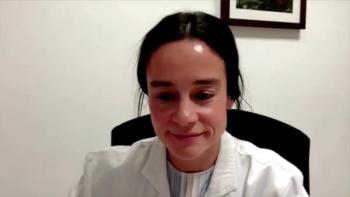
Using Active Surveillance to Spare Men From Unneeded Prostate Cancer Treatment
Advances in technology have made active surveillance in men with prostate cancer possible and prevented treatment for men who don’t need it, said Matthew Nielsen, MD, FACS, chair, Department of Urology, University of North Carolina School of Medicine.
When active surveillance in prostate cancer was first being done, it made a lot of people very nervous, but it has since been proven to avoid unnecessary care that would negatively impact quality of life in many men, said Matthew Nielsen, MD, FACS, chair, Department of Urology, University of North Carolina (UNC) School of Medicine.
Transcript
What have we learned about active surveillance and the ways patients with prostate cancer who should be placed on active surveillance benefit?
Yeah, it's been really interesting for me. I have a fair amount of gray hair, but I'm not that long into my practice, but even in the 16 years that I've been practicing at UNC Chapel Hill, I've seen a big change in the way that patients even think about active surveillance. One of my mentors at Johns Hopkins was one of the people who first started doing active surveillance in the early ’90s. At that time, it was really controversial. Patients were really anxious [and] a lot of neurologists were really anxious, because we were talking about taking a man with a very, very curable cancer and doing something other than going after aggressive curative treatment. Thankfully, [there were] those brave doctors and patients who did surveillance early on and helped [by] coming to meetings, like the AUA meeting, to share the results of their experience [and they] have helped us learn that it's a great option for many, many men. And it's probably an option for patients with other kinds of cancer that we can learn from.
We've been seeing in national data—from AQUA and places like that—experience that would support my anecdotal experience of doctors getting more comfortable with it, patients being more comfortable with it. [We’re] now seeing that it is a way for us to uncouple diagnosis from screening. There [are] a lot of very thoughtful people who are concerned about screening healthy, asymptomatic people who are blissfully unaware of some very, very early health problem, and potentially subjecting them to treatments that may cause an immediate impact on their quality of life—prostate cancer being one example, but there are others. To the extent that we can really refine and get more competent in where surveillance is a good option for a person [and understand] when that window of opportunity for cure is still open. As we gather more information with continuous risk reassessment, [we can] pull the trigger on treatment before that window closes, and thereby bypass treatment for a large, large fraction of men. But for that small fraction who do need treatment, not push it off too far.
We've been really lucky as a field, to have a lot of advances in technology that have helped us with that. When I was going through training, advanced imaging with things like MRI, we're really in the sort of investigational stage. It wasn't commonly used in clinical practice. Now, it's very widely used and has been an incredibly helpful tool. It helps us even uncouple [prostate-specific antigen] screening from biopsy. We're being enabled now to have a really precision oncology approach with early detection of prostate cancer: identify men who are at greater risk—Black men in the US have a significantly higher risk of developing and dying from prostate cancer, and that's been the case for a long time. That access risk went down very steeply when PSA screening came online, and there have been concerns in recent years, that the shifts that
We are very, very keen on thinking about surveillance and applying technology like MRI, to help us understand and be in dialogue with our primary care colleagues—who raise good questions about potential harms of overtreatment—to engage in that conversation on behalf of our patients to focus treatment very precisely on the men who need it, but spare the large fraction who may not in a way that we can still sleep at night.
Newsletter
Stay ahead of policy, cost, and value—subscribe to AJMC for expert insights at the intersection of clinical care and health economics.








































